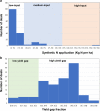Energy implications of the 21st century agrarian transition
- PMID: 33875657
- PMCID: PMC8055646
- DOI: 10.1038/s41467-021-22581-7
Energy implications of the 21st century agrarian transition
Erratum in
-
Author Correction: Energy implications of the 21st century agrarian transition.Nat Commun. 2021 Jul 16;12(1):4477. doi: 10.1038/s41467-021-24752-y. Nat Commun. 2021. PMID: 34272377 Free PMC article. No abstract available.
Abstract
The ongoing agrarian transition from small-holder farming to large-scale commercial agriculture is reshaping systems of production and human well-being in many regions. A fundamental part of this global transition is manifested in large-scale land acquisitions (LSLAs) by agribusinesses. Its energy implications, however, remain poorly understood. Here, we assess the multi-dimensional changes in fossil-fuel-based energy demand resulting from this agrarian transition. We focus on LSLAs by comparing two scenarios of low-input and high-input agricultural practices, exemplifying systems of production in place before and after the agrarian transition. A shift to high-input crop production requires industrial fertilizer application, mechanization of farming practices and irrigation, which increases by ~5 times fossil-fuel-based energy consumption compared to low-input agriculture. Given the high energy and carbon footprints of LSLAs and concerns over local energy access, our analysis highlights the need for an approach that prioritizes local resource access and incorporates energy-intensity analyses in land use governance.
Conflict of interest statement
The authors declare no competing interests.
Figures





References
Publication types
LinkOut - more resources
Full Text Sources
Other Literature Sources

